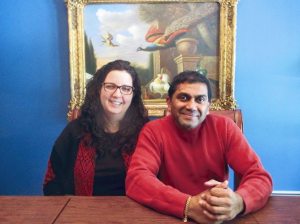There’s a heron outside Kim and Pat Pitchayan’s Old Westbury home, standing watch over the pond and stream at the front door. The heron is fiberglass, but it does a good job of scaring off any real herons that might spot the Japanese koi that live in the pond. It’s a little harder protecting the Pitchayans’ chickens since raccoons and hawks sometimes get into the coop.
When Kim and Pat decided to move to Long Island from Flushing 13 years ago, they looked for a house with lots of land where their sons, Sumu, Mahesh and Karthik, would have plenty of room to play outdoors and they could raise animals. A compelling selling point of the house they ultimately chose was that the property borders the Wheatley Woods, an undeveloped section of land behind The Wheatley School that was once the Hempstead Plains, but is now covered with trees.

It was the dilapidated chicken coop in the far back corner of the yard that probably was the clincher for Pat.
“I always wanted a house with a chicken coop,” said the attorney. An animal lover, Pat bred fish as a hobby in his native Singapore, maintaining 20 tanks.
Through a company in Texas, the Pitchayans ordered “the exotic breed,” a combination of uncommon chickens from breeds such as Araucanas, known for their blue eggs; Cochins with blazing red, orange and gold back and neck feathers; black and white Campines and Exotic Polish whose head feathers, in the white-crested variety, look like a giant ball of cotton.
Peacocks became part of the scene a few years ago when the Pitchayans were awakened at 5 a.m. by noise from the coop. Two pea fowls—a peacock and a peahen—had arrived and were looking at the chickens. For three days, they hung out in the yard, catching bugs in the air by the pond. Then they flew off, perhaps back to nearby Westbury Manor where peacocks roamed the grounds. That reignited the Pitchayans’ desire to raise pea fowl. They found a now-retired breeder of pea fowls in Hicksville. Kim recalls that the breeder visited their house first to make sure it was a suitable environment for his animals. Then, Pat and the boys went to the hatchery to catch the birds. Today, there are two couples residing in a pea fowl house next to the chicken coop.

The bird population is not limited to the outdoors. Inside lives a 12-year-old African gray parrot. It’s very messy, Pat complains, but it’s happily perched in a cage outside the music room, occasionally squawking.
There is other animal life in the Pitchayans’ household. The family has two dogs and for a while, they had a goat and sheep. The goat ate leaves—including poison ivy—and the sheep kept the grass trimmed. But, when the goat starting eating leaves off the fruit trees, it was time to say goodbye.
Since the Pitchayans are vegetarians and not big egg eaters, the main reason for breeding the chickens is their charm. When there are too many males (“You don’t need males to get eggs,” says Kim), they give them away to anyone who wants them. “But the new owner has to kill the animal,” she said.
“Raising the chickens is therapeutic,” said Pat. “It’s pleasant to see them roam.” Kim agreed. “I’m amazed at how long people can stand there and just watch them.”
When the boys were little and had playdates at the house, Kim says that the friends would often beg their parents to get them chickens, too. “Though I don’t think any of them actually did,” she said, nothing that raising chickens has become desirable, but not all towns permit them.

How has this unusual experience shaped these suburban teens? “The connection they all have to nature, having watched eggs hatch and then seeing chickens grow—and learning what pecking order really means—is truly amazing,” said Kim. “Watching how the peacock pines for the peahen when they’re separated, it’s a really beautiful experience.”
Kim has no doubt that being raised around livestock has totally changed their lives.
“Growing up surrounded by these animals has enriched the boys in so many ways. It’s who they are now. They have a certain color and richness to life. It’s been such a special experience being so close to nature and having such a connection.”




























